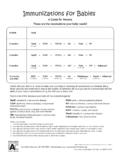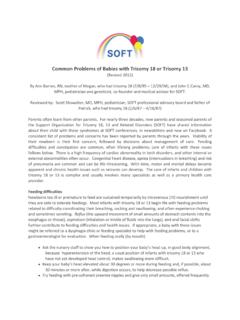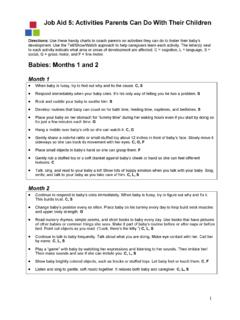Transcription of Africa’s newborns– 1 - World Health Organization
1 Over a million African babies are estimated to die in the first 4 weeks of life but mostdie at home, uncounted, and invisible to national and regional policies and programmes. To reducethese deaths, we need information. Are we making progress towards Millennium Development Goal 4for child survival? Where, when, and why do these newborn deaths occur? How does newborn healthlink with the Health of mothers and older children? Global estimates suggest that over two thirds of newborns could be saved through existing maternal andchild Health programmes. How many babies in Africa could be saved with interventions that are alreadyin policy in most African countries and yet do not currently reach the poor? How could healthinformation be improved and used to count newborns and make them count?Africa s newborns counting them and making them countJoy Lawn, Pyande Mongi, Simon Cousens112 Opportunities for Africa s NewbornsAfrica s uncounted newborn deathsEach year in Africa, around a quarter of a million womendie of pregnancy related causes and approximately 1million babies are stillborn, of whom at least 300,000 dieduring labour.
2 A further million babies die in theirfirst month of life up to half on the first day andanother million children will die before they reachtheir fifth birthday. Four million low birthweight babiesand others with neonatal complications live but may notreach their full potential, and a similar number of Africanwomen have non-fatal complications of generations in Africa, this litany of loss lost livesand lost potential for better lives has been consideredthe norm. Many of these deaths, especially stillbirths andearly neonatal deaths occur at home, unseen anduncounted in official statistics. In many societies, babiesare not named until six weeks of life and may not bebrought into society until an older age. These traditionsmean that when a baby dies, the mourning of mothersand families is often hidden. Thus these traditionscontribute to concealing the size of the problem and helpto perpetuate a resigned acceptance of birth as a time ofdeath and danger for both mothers and babies .
3 The lack of public recognition of so many deaths amongbabies in Africa, and the apparent acceptance of thesedeaths contrasts with the mountains of reports andpaperwork generated by the death of one baby in theindustrialised World and the public outcry if substandardcare is suspected. Yet a century ago, maternal andneonatal death rates in Europe were similar to those inmuch of Africa today. In 1905 the neonatal mortality rate(NMR) in England was 41 per 1,000 live births1 theaverage for sub-Saharan Africa today. By 1950 the NMRin England had halved (to 20 per 1,000) despite twoworld wars and a decade of economic depression. TheNMR had halved again by 1980, even before intensivecare became available for babies . How can Africa, with all her challenges, accelerateprogress to reduce maternal, neonatal, and under-fivemortality rates by at least half in the next decade in orderto meet the Millennium Development Goals? Animportant cornerstone for progress is to make better useof existing data, to improve the data and to connect thesedata to action.
4 Much information is available, but we donot always use it well, either to improve programmesespecially at the district level or to present the case formore investment. The numbers of women and childrendying and the steps which could (and should) be taken toprevent these deaths should not just reach technical andpolicy audiences, they should be available to families andcivil society. African newspapers regularly report newsabout HIV/AIDS and hold governments accountable forprogress. Maternal, newborn, and child deaths rarelymake the news they are an uncounted daily achieve real progress, we must find ways to empowerfamilies and communities so that they can change what iswithin their power and demand their right to accessessential quality healthcare. Ending the suffering begins with counting each death andmaking every death count. Progress builds on counting each birth and making eachmother and child count and receive the essential healthcare that is their towards MDG 4 in Africa newborn survival is keyThe Millennium Development Goals (MDGs) are themost widely ratified Health and development targets inhistory.
5 Nearly every nation has agreed to reach theseeight interlinking goals addressing poverty, hunger,education, and Health by 2015. Multiple reports havebeen published, many commitments have been made but are we making progress? Are fewer mothers andchildren dying? Is access to essential Health careimproving for the poor? The target of the fourth MDG is a two-thirds reductionin under-five mortality between 1990 and 2015. In Africathe average annual decline in under-five mortalitybetween 1960 and 1990 was two percent per year, butprogress since 1990 has been much slower at percentper (Figure ) Understanding why progress hasbeen slow is essential if we are to improve the situationfor mothers and newborns in Africa. While the huge impact of HIV/AIDS and macro-economic factors have often been cited as reasons for slowprogress in reducing child mortality in Africa,2anotherimportant barrier to progress is the failure to reduceneonatal deaths (deaths in the first four weeks of life).
6 Child survival programmes have primarily focused onimportant causes of death afterthe first four weeks of life pneumonia, diarrhoea, malaria, and vaccine preventableconditions. However, in the last few years it has becomeobvious that deaths during the first weeks of life(neonatal deaths) account for an increasing proportion ofunder-five deaths. Globally, almost 40 percent of under-five deaths are every four children who diein Africa, one is a newborn. As child Health programmessucceed in reducing deaths after the first month and yearof life, an increasing proportion of under-five deaths willbe neonatal, and action must now be taken to reducenewborn deaths can be reduced by strengtheningnewborn care within existing child and maternal healthprogrammes (See Section II and III) and by moreattention to reaching the unreached. (see Section IV) Opportunities for Africa s Newborns 131 MDG 4 - new hope in Africa?The slow average decline in the under-five mortality rate(U5MR) across Africa hides important differencesbetween countries.
7 Since the 1990s, some countries, mostwith high HIV prevalence, have seen increases in countries include Botswana, Zimbabwe, Swaziland,Kenya, and C te d Ivoire. Most African countries,including many of the larger countries, have experiencedeither static U5MR for the last decade or have mademinimal progress. Yet some countries have made excellentand consistent progress in reducing deaths amongchildren under-five. Eritrea is an example of such acountry, having achieved an average annual reduction inunder-five mortality of 4 percent since 1990 despitehaving one of the lowest gross national incomes (GNI)per capita in the World and having experienced a war(Figure ).To meet MDG 4, sub-Saharan Africa will need to achievean annual average reduction in under-five mortality of atleast 8 percent per year for the next decade. Four highburden countries with stagnant U5MR in the 1990s Tanzania, Malawi, and Ethiopia have reported 25 to 30percent reductions in U5MR over the past few yearsbased on data from Demographic and Health Surveys(DHS) released in the past year (Figure ).
8 Thesestatistics equate to annual reductions of over five percentand suggest that major decreases in child mortality can beachieved. However, a note of caution is required when interpretingthese data: there is uncertainty around the estimates ofU5MR, and particularly NMR from DHS. Prospectivepregnancy surveillance data indicate that DHS tend tounder-report early neonatal ;6 The data arediscussed in more detail in the data notes (page 226).FIGURE towards MDG 4 inEritreaFIGURE towards MDG 4 tosave the lives of children in Africa more attention is needed to reduceneonatal deaths FIGURE towards MDG 4 inTanzania Mortality among children under five years in Africa appears tobe decreasing after a decade of little progress But there has been little progress in reducing neonatal deaths,and 25 percent of under-five deaths in Africa are now neonataldeaths million a year There has been no measurable progress in reducing deathsduring the first week of life To achieve MDG 4, newborn deaths must be strengthening of both maternal and child healthservices and integration with other programmesMDG 4 progress is detailed in the country profiles for in each of sub-SaharanAfrica s 46 countries (page 174).
9 See data notes for more information. The 2005result includes DHS results from 8 countries which are has made consistent progress in reducing under-fivedeaths. Despite a gross national income per capita of only $180,the pace of decline is among the fastest in any developingcountry. Reasons for this progress in Eritrea and in 6 otherAfrican countries with relatively low NMR will be explored inmore detail in Section Eritrea country profile (page 189)Tanzania has just reported a dramatic 32% reduction in under-five mortality since the last DHS 5 years ago. While thereduction in NMR was smaller (20%), this is still substantial andequates to 11,000 fewer babies dying each year (see Tanzaniacountry profile on page 216). This corresponds to annualreduction of in U5MR. If this progress could be sustainedfor the next decade,Tanzania would meet MDG Tanzania country profile (page 216) See data notes for more information on data definitions and limitations. The2005 result for Tanzania includes DHS results for NMR and U5MR which and child deaths in sub-Saharan AfricaYe arLate NMRE arly NMRU nder 5 Mortality RateInfant Mortality RateMDG4 Target9716405010015020025030019601970198 0199020 0201060Ye ar1970 19801990 2000 20101960 Mortality per 1000 birthsNeonatal Mortality RateUnder 5 Mortality RateMDG4 Target01002003003211254 Year24821970 1980 19902000 201001002003001960 Mortality per 1000 birthsNeonatal Mortality RateUnder 5 Mortality RateMDG4 Target4514 Opportunities for Africa s NewbornsWHERE in Africa do newborns die?
10 Africa accounts for 11 percent of the World s populationbut more than 25 percent of the World s newborn the 20 countries in the World with the highest risk ofneonatal death, 15 (75 percent) are in highest risk countries Liberia has the highest risk of newborn death, with of babies dying in the first month of life. Manyof the 10 African countries with the highest risk ofnewborn death are countries that have experienced war orother disasters. However, the list includes countries suchas Mali and Nigeria, which have been politically stableand have relatively high GNI per capita compared toother African countries with much lower , countries with higher NMR have moredeaths that result from easily preventable causes (seeWHY do African newborns die?page 15). Thus thesecountries have the greatest opportunity to save the mostlives at the lowest cost and in the shortest time. The lowest risk countries Some African countries have NMRs similar to those ofindustrialised countries, though the three countries withlowest NMR are all island states with small populationsand relatively high GNI (US$1,770 to US$8,090).
















